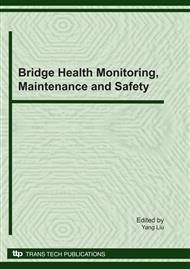p.1
p.13
p.23
p.37
p.51
p.67
p.77
p.89
Modal Test and Analysis of a Bridge under the Varying Temperature Condition
Abstract:
To consider the effect of varying temperature on dynamic properties of bridge structures, a continuous modal test for a suspender bridge was carried out. Firstly, a long-term modal test is conducted, and the first five modes (frequencies, damping ratio and modal shapes) under different temperature are identified by modal parameter identification. Secondly, the comparison between the analytical dynamic properties and measured results are analyzed, and the changing regularity of this structure under varying temperature is summarized. The results show that the frequencies of this bridge increase as the ambient temperature decrease, and that the damping ratio and modal shapes are not sensitive with the ambient temperature. Finally, the relationship model between the environmental temperature and frequencies of this bridge model is obtained by regression analysis. The confidence interval of undamaged structure is obtained, and then this confidence interval is applied to assess the condition of this bridge.
Info:
Periodical:
Pages:
1-12
Citation:
Online since:
December 2010
Authors:
Price:
Сopyright:
© 2011 Trans Tech Publications Ltd. All Rights Reserved
Share:
Citation:


